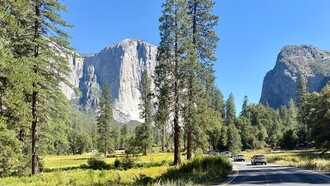Route: Ajmer to Beawar on National Highway 8 and from Beawar on National Highway 14 to Abu Road via Pali and Sirohi.
Distance: 360 Kms.
Driving Time: 8 – 9 Hours.
Notes: In the days of yore Ajmer used to be the residence of the mighty Mughals and is a major place of pilgrimage for the Muslims. It is an easy going an interesting town that nestles in the foothills of the scenic “Ajay Meru” and is most renowned for the tomb of the much-venerated Sufi mystic – Khwaja Moinuddin Chisti. The journey by road to Mount Abu, Rajasthan’s only hill station is full of enchanting North Indian countryside charms, pastoral landscape, rustic villages and plenty of picturesque on-the-way locales that makes it a journey worth embarking upon. The wayside amenities in the form of highway Dhabas, North Indian & Tandoori eateries and other miscellaneous roadside stalls cater to the exacting needs of the motorists on the way.
Ajmer
The city of Ajmer is a green oasis on the shores of the sparkling Anna Sagar Lake and surrounded picturesquely by the undulating Aravalli hills. The city rose like a phoenix from the foothills of Taragarh hills way back in 145 A.D. It is used to be an integral part of the Mewar kingdom till the 19th century and has the distinction of being the last Indian district to officially unite with the princely state of Rajasthan. The Mughal architectural grandeur is there for all to see, courtesy a plethora of Mughal edifices dotting this incredible city. The city is steeped in legends and medieval folklore.
What to See
Anna Sagar Lake, Dargah, Akbar’s Palace, Adhai-Din-Ka-Jhonpra, Nasiyan Temple, Daulatbagh Gardens.
Where to Stay:
Kutchman Fort, Mansingh Palace, Hotel Ambassador, Hotel Regal, Omni Palace, Phool Mahal Palace, Hotel Aaram, Hotel Malwa, Hotel Siddharth, Hotel Shanti Mahal, Hotel Kanak Sagar, Hotel Master Paradise, Haveli Heritage Inn, Darbar Palace, Hotel Champa Mahal.
What to Eat:
Bhola Hotel, Club, Haveli Heritage Inn, Honey Dew, Hotel Hayatt, Hotel New Park, Sheesh Mahal, The Davat. The later offers Indian, Continental, Chinese, Mughlai (Pure Vegetarian) fares and is top rate in terms of quality.
What to Buy:
Ethnic jewelry, handmade shoes, Bandhni Sarees, Brass utensils, intricately designed woodcrafts, leather bags as well as the indigenously produced Ittar perfume.
Pali and Sirohi
On the way to Mt. Abu, you will come across charming Rajasthani towns like Pali and Sirohi. While the charming town of Pali, presently a district headquarter, used to be a much sought after trading hub during the 11th and 12th century, the town of Sirohi located to the Southwest of Rajasthan with an area encompassing all of 5139 Sq. Kms. is among the smallest districts of Rajasthan and is home to the exotic Bhil and Grasiya tribes of Rajasthan.
The Bhils known for their hunting skills still practice Bull-hunting in Sirohi and its surrounding areas. It is a fascinating experience to pass by enchanting Bhil and Grasiya villages, most of them being located in the foothills and some are even located in close proximity to to cascading waterfalls, all of which makes travel through this region a truly outstanding experience. The ethereal charm of passing by tribal hamlets with the traditional tribal huts made of earthen tiles that are baked in fire to be weather resistant along with bamboo and wood, makes for a surreal sight.
Mt. Abu
Rajasthan’s only hill station spreads out along a 1200 meters high plateau in the southern tip of the state. It is a pleasant hill station and mostly preferred by Indian tourists. It is a much preferred honeymoon destination for the people of Gujarat and Rajasthan. The main part of the town extends along the road in the form of Abu Road all the way down to the Nakki Lake.
During the British Raj, Mt.Abu used to be the ideal summer retreat of the Viceroys and other royal families of Rajasthan. The Victorian Bungalows that dot the hilly landscape still resonates with the Raj era ambience. For the faithful, Mt. Abu is renowned for its Dilwara Jain Temples that attracts hordes of pilgrims every year.
What to See:
Nakki Lake, Sunset Point, Honeymoon Point, Crag’s and Robert’s Spur, Adhar Devi Temple, Dilwara Jain Temples, Achalgarh, Guru Shikar, Gaumukh Temple, Trevor’s Crocodile Park and Mount Abu Wildlife Sanctuary.
Where to Stay:
Mt. Abu STD: 02974
Palace Hotel (238673), Hotel Hillock Mount Abu (238463), Connaught House (235439), Cama Rajputana (238205), Hiltone Hotel (238391-94), Sunrise Hotel (235573,238775), Jaipur House (235176/001), Hotel Shikar (238944)
Where to Eat:
In terms of cuisine there isn’t much variety at Mt. Abu. The golden rule is to stick to the traditional Indian eateries rather than trying out fancy Chinese or Continental menus, which are mostly below par. Arbuda Restaurant, Arbuda Motorway, Hotel Akashdeep, Kanak Dining and Jodhpur Bhojanalaya are the popular eating joints of Mt. Abu.
What to Buy:
The principal shopping district of Mt. Abu is in and around the Nakki Maal where tourists can buy ethnic Rajasthani and Tribal jewelry, fabrics, wooden crafts and gemstones. Drop in at the Rajasthan Government Emporium for authentic handicraft items of Rajasthan.















